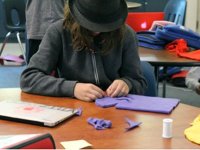6 Reasons Why Puppets Will Change Your Classroom Forever
Puppet-based learning teaches students design thinking, growth mindset, writing, how to work in sharable media, and how to approach learning without fear. Plus, it’s fun!
Your content has been saved!
Go to My Saved Content.Editor's note: High school English teacher Cheryl Morris co-authored this post.
Good help is hard to find, and real friends are made. In our classrooms, we take that literally.
Puppets change the entire classroom by creating more possibilities for creativity, collaboration, critical thinking, and curiosity. They give students a (sometimes silly) voice and put them in the role of creator. They can also be a co-teacher, a physical avatar, a learning partner, and even facilitate learning by subverting the ego.
The Benefits of Puppets in Class
1. Design Thinking
Your students can build puppets. With a thoughtful approach to building a puppet, they can design their ultimate learning partner.
2. Growth Mindset
Puppet creation requires making mistakes. Your first puppet will always be very, very special. Students learn fairly quickly that what they see in their mind is not the same as what they can make with their hands. Abraham Lincoln turns into a Rastafarian cyclops. Taylor Swift becomes a married older chicken. Mistakes in puppet making allow kids to fail in a very low-risk way. They get a practical lesson in imperfection. They also get a lesson in following directions. Some students cut a hole, rather than a straight line, for their mouth. Helping them fix their mistakes reinforces the establishment of a growth mindset.
3. Sharable Media
Privacy concerns are ever-present, especially for elementary and middle school teachers. Students should be creators to show both content mastery and content-specific skills, but when they create their videos, it's ethically hard to share them to give students an authentic, real-world audience. With the puppets as physical avatars for students, videos become sharable so that students get the benefit of a wider audience and feedback while still being protected.
4. Puppet as Co-Teacher
When you make a video to introduce a topic or app, use a puppet. The attention that your students pay is different. I enjoy letting the puppet kick off a lesson, and then I help in the room.
5. Writing With a Puppet
When students write plays, foremost in many of their minds is how they will look, how they will sound, and how others will respond to them. Writing for the puppet allows them to be far more silly, as well as take risks with accents, characters, and plots that they wouldn't try if they were required to act it out live. Not only does it help them learn the content as well as writing skills and dialogue formatting, but they also learn important lessons in collaboration, communication, critical thinking, and creativity.
Cast of Characters:
Human Name: Puppet Name, Character Played
- Emily: Duck, Menes (scribe)
- Reed: Rocco, Mohar (soldier)
- Polo: Wiz, Nafi (priest)
- Emily: Mirabel, Nefertari (farmer's wife)
- Bobby: Tyrone, Sebek (farmer)
6. Making Learning Less Threatening
We take risks all the time in learning -- and sharing out is the worst. Using a puppet transforms getting caught in the headlights into shining in the spotlight. Students share with less risk, and the puppet makes the situation a lot more like a performance.
Building Puppets to Transform Your Teaching Life

Puppet making may seem difficult, but many puppet makers show their entire process through YouTube videos. We couldn’t find a pattern that was scalable for an entire class, so we made our own and created instructional videos that we use in class and in workshops. A basic Muppet-inspired hand puppet doesn't require sophisticated sewing or crafting skills, either. Even sixth grade students learn how to sew a seam and use a hot glue gun fairly quickly.
However, there are things we do to speed up the process. Students begin with a design and a color choice. Before the next class period, we cut the fleece into the pattern. Then, with help from our instructional videos, students walk through the process at their own speed. With younger students, we tend to control the resources, because left unattended, a 12-year-old will cut a circle out of the center of a piece of felt and throw the rest of the sheet away. So we're in charge the fabric and felt scissors.
To speed up the process, we have also pre-cut cardboard for mouths, tear strips of duct tape for thumb and finger loops to work the jaws, and pre-cut felt for the mouth interior. The goal is that students focus on the actual process of building and designing the puppet rather than cutting perfect half-circles and measuring correctly.
That being said, making mistakes is essential to this process. The first time we taught students how to make puppets, we had never made puppets either. Learning with your students lets them see you as a fellow learner, rather as a didactic answer machine. Not knowing the answer to something teaches students how to find their own answers, which is useful for the rest of their life.
Puppets have so many applications in the classroom: we’ve used them to:
We believe that puppets belong in every classroom. Share your puppet story with us (or ask your puppet questions) in the comments.
